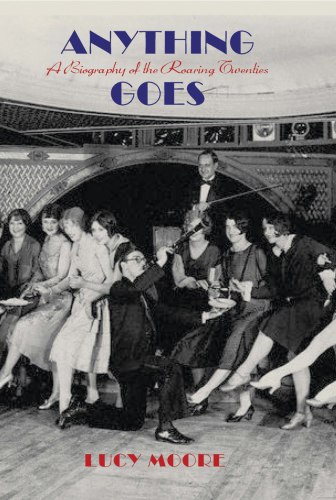
Anything Goes
A Biography of the Roaring Twenties
کتاب های مرتبط
- اطلاعات
- نقد و بررسی
- دیدگاه کاربران
نقد و بررسی

January 25, 2010
Quickstepping over the surface of the 1920s, a high-octane and high-speed decade that F. Scott Fitzgerald christened the Jazz Age, U.K. writer Moore (Maharinis
) emphasizes that the 1920s was a time a lot like our recent past. Moore approaches her material thematically more than chronologically, centering on the usual 1920s icons, from Al Capone to flappers, which permits her to examine how revolutionary a period it was, despite the narrower materialistic pursuits. Anthropologists like Margaret Mead redefined traditional roles as mere social constructs. It was the age of cigarettes, drugs, and newly liberated flappers; of Carl Van Vechten and Langston Hughes combating rampant racism; of liberated Hollywood women Mary Pickford and Gloria Swanson as well as Charlie Chaplin and the even-more scandalous “Fatty” Arbuckle; of xenophobia cheek by jowl with the urbanity of the New Yorker
and the Algonquin Round Table. It was the age of Lindbergh and flight and of the less heroic automobile. This illicit-booze-fueled decade of conspicuous consumption came down with a crash in 1929, and Fitzgerald wrote elegiacally, “we will never feel quite so intensely about our surroundings any more.” This lightweight survey is best suited for readers not deeply familiar with this much revisited decade.

December 15, 2009
Moore (Liberty: The Lives and Times of Six Women in Revolutionary France, 2007, etc.) delivers a fast-paced portrait of the 20th-century's fizziest decade, replete with gangsters, flappers, speakeasies and jazz.
The author's breezy style synchs nicely with her subject matter, and her focus on the personalities behind the history keeps the narrative engaging. Rather than presenting her material as an extended survey of the period, Moore focuses on a single Jazz Age trope per chapter, resulting in easily digestible takes on prohibition and the high-spirited criminal culture it engendered; the explosion in popularity of jazz music; the evolution of the flapper; the emergence of Hollywood as creator of a national cultural consciousness; the financial scandals of the Harding presidency; the Sacco/Vanzetti and Scopes trials; the resurgence of the Ku Klux Klan; the Algonquin round table and the founding of the New Yorker; Charles Lindbergh's historic trans-Atlantic flight; the spectacular boxing career of Jack Dempsey; and the financial devastation of the Wall Street crash that ended the party and ushered in the Great Depression. The author writes more like a novelist than a historian, richly delineating her characters and their milieu. Harding is revealed as a hapless, good-time Charlie hopelessly out of his element as president; Scott and Zelda Fitzgerald, beautiful and damned, drink their way across Europe; blues legend Bessie Smith lives large and brooks no fools; and communist anarchists Sacco and Vanzetti emerge as principled, quietly noble figures, unrepentant in the face of a likely gross miscarriage of justice. Moore draws some fairly obvious parallels between the'20s and our contemporary moment—the Wall Street crash, Bush as Harding redux, the gap between emerging technologies and social structures, the cult of celebrity—but the point isn't labored and the fizzing pace never flags.
Snappy, vivid account of America's most glittering decade.
(COPYRIGHT (2009) KIRKUS REVIEWS/NIELSEN BUSINESS MEDIA, INC. ALL RIGHTS RESERVED.)

January 15, 2010
Does Moore ("Liberty: The Lives and Times of Six Women in Revolutionary France") want to be the next Christopher Hibbert? Hibbert, who died in 2008, wrote seemingly effortless studies of all manner of people, places, and erasall elegantly accessible, meticulously researched books. Readers used to his high standards for popular historyand anyone who knows anything about the 1920swill be disappointed by Moore's book. It amounts to a portrait of the era, chiefly in America, as it could have been written decades ago: there's F. Scott Fitzgerald and the ex-pat Murphys, Al Capone, the Algonquin Roundtable, Sacco and Vanzetti, a one-dimensional Warren Harding, the Scopes trial, and a Hollywood rife with scandal and apparently oblivious to any struggle over the use of sound in film. You'll hope in vain for Moore to demonstrate some special expertise, but 1920s MGM icon John Gilbert's one unindexed presence as "Jack Gilbert" with no apparent awareness by Moore of whom she's speaking is emblematic of her shallow knowledge. Any of these topics, plus the many that Moore excludes, get better treatment elsewhere. VERDICT Perhaps middle or high school students or general readers first embarking on the era will appreciate this. Others should pass.Margaret Heilbrun, "Library Journal"
Copyright 2010 Library Journal, LLC Used with permission.

February 15, 2010
The term Roaring Twenties connotates an era of uninhibited excess, characterized by drinking, shameless flappers, jazz, and gangland wars. All of these aspects are covered in this enjoyable, if uneven, survey of the decade. Moore also convincingly asserts that this was a period of significant social and political change with long-term effects. Utilizing a topical approach, she offers interesting descriptions of the emergence of organized crime, the excesses of big business, the Harlem Renaissance, and the stirrings of civil rights activism. She provides many useful tidbits about personalities as varied as Al Capone and Marcus Garvey. As long as Moore stays with her descriptive narrative, her account moves along smoothly. Unfortunately, her efforts to analyze these trends and to link them to our current economic and political conditions dont ring true and are often based upon unwarranted assumptions. Still, for general readers, this work provides an interesting and wide-ranging look at a tumultuous period.(Reprinted with permission of Booklist, copyright 2010, American Library Association.)

























دیدگاه کاربران